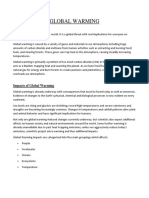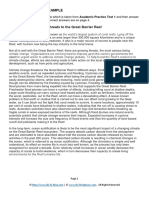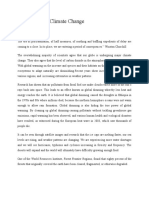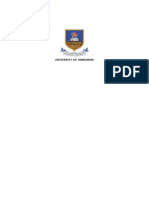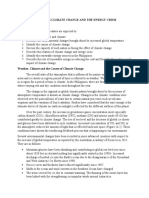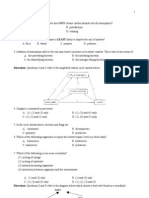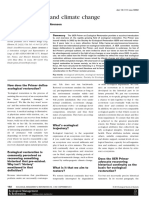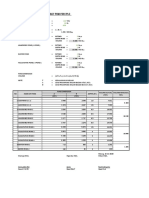Assingment Water
Uploaded by
hamizackAssingment Water
Uploaded by
hamizackTHE EFFECT OF GLOBAL WARMING TO OUR WATER RESOURCES
1.1
Introduction
Many water supply sources (rivers, lakes, groundwater basins, etc.) are already over allocated, suffer degraded water quality, and are often not in sufficient condition to support endangered species. Climate change will exacerbate these water challenges, leading to insufficient water for people and the environment and making it increasingly difficult to meet the needs of both.
mplementing actions now to improve water quality and supplies, protect aquatic ecosystems, and improve flood management not only makes sense, but early action will also help reduce future impacts related to climate change. !ven if greenhouse gas emissions are reduced today, there is already warming "in the pipeline# that will create additional impacts. $daptation is not a solution to climate change, but given the importance of our water resources, immediate action is needed to avert significant societal impacts.
%lobal warming occurs because of climate change, also known as climate disruption. Climate is a fundamental driver of the water cycle. t determines how much water is available (supply) and how much water we need (demand) in the short and long term. &he 'nited (ations )ramework Convention on Climate Change ('()CCC) defines climate change as, "a change of climate which is attributed directly or indirectly to human activity that alters the composition of the global atmosphere and which is in addition to natural climate variability observed over comparable time periods#.
Climate change has an impact on weather and changes in weather patterns determine variability in water supply and demand on a day+to+day and season+to+season basis , the weather one year may be drier or wetter than the last. Changes in temperature and precipitation patterns have affected the water cycle by changing its availability, quantity and its quality. -ith raising atmospheric temperature and increase rate of evapotranspiration the demand for water from human beings and the agriculture sector will also increase. -ithout adaptation and mitigation measures, climate change may threaten the sustainability of water systems, irrigation systems and farming systems.
Climate change is primarily caused by the growing concentration of heat+trapping gases in the atmosphere, often referred as greenhouse gases. &he increase of carbon dioxide, methane, and other greenhouse gases has may many causes, but most of the increase result from human activities, such as deforestation, pollution and burning fossil fuels.
1.2
The E ect! o G"o#$" W$r%in& to W$ter Re!ource!
%lobal -arming will have changes in the availability, quantity and quality of our water resources, which will have impacts on the whole cycle of water supply, i.e. from water demand, water resources and the water infrastructures. &he effects of global warming are vast and cover every sphere of one/s life. 0oth the nature and the living beings are suffering from the effects of global warming. f we do not take note of the alarming rate of growing global warming then our earth might cease to exist someday. &he water resources have been heavily affected by the global warming phenomenon. 1ea levels have risen, glaciers retreats are taking place often and the most harmful affect is the shrinking of the $rctic Circle. &his phenomenon has caused concerns among all the sectors and geo+engineering is considered to be a way of mitigation.
f we put it simply then the water bodies would be affected during the long and scorching summers since the rate of evaporation would increases with hotter summers. -ater cycle is important for any kind of human activity and global warming would adversely affect this cycle causing a topsy turvy in the human activities as well as the climactic changes. %lobal warming might also lead to floods. &he water levels in many regions would lower due to excessive evaporation and this would cause in torrential downpours increasing the chance of deluge.
&he acceleration in the phenomenon of global warming has caused the ice sheets in the -est $ntarctic Circle and %reenland to shrink. Carbon sediments have been released in the air and due to the increase of carbon emission the reduction in the ice sheets has taken place. &his reduction might cause a huge flood around the world. 0y the end of 2
twenty first century the water in the sea is expected to rise by 3.*+ .2.. inches. 4ue to the augmentation of global warming effects the &hermohaline circulation might as well get disrupted. &he fresh water from the 5olar 6egions would interrupt the %ulf 1tream causing this distress. &he implication of a change of course of the gulf stream would have worldwide effect that would drastically accelerate climate change and extremes.
&he imbalance created in the water cycle by global warming has far reaching effects. 1ome places on the earth would face extreme temperatures along with torrential rainfall while others would face scarcity of water and drought. n fact, according to the scientists this phenomenon of global warming might even cause desertification in the extreme &ropical areas like $frica.
&he glacier rich areas like -estern (orth $merica, $sia, $lps, ndonesia and $frica are suffering badly due to global warming. &he melting of glaciers in these regions has raised concerns regarding the increase in water levels. 7cean circulation also suffers due to global warming. &he oceans act as the absorber of carbon dioxide and when it reaches the saturation point it fails to absorb any more carbon dioxide. $s a result the ocean surface becomes warm.
$cidification of oceans is caused due to the concentration of carbon dioxide in the atmosphere. &his is an indirect effect of global warming causing distress to people worldwide. &he rise in sea level would cause infiltration of the saline water into the groundwater. &his will pose as a potential danger for the health of the living organisms.
1.'
Ch$n&e in W$ter (e%$nd )$ttern
4uring dry spells, the consumers will tend to consume more water either by watering the garden or bathing more frequently. &o ensure the existing water infrastructures could cope with the water demand, contingency measures such as banning of car washing and watering the garden has to be implemented during extreme drought, if needed.
1.*
I%+$ct on W$ter Re!ource!
&he climate change will affect water yield from the reservoirs, surface water and ground water. -ith the change of rainfall patterns whereby a reservoir catchment area may receive higher rainfall within a shorter duration but the reservoir storage capacity was not designed to contain such high rainfall and the excess water could not be harvested and will be ended up in the ocean. $t the same time, the reservoir catchment area may also experience a dry season with lower rainfall, higher evaporation rate and extended dry period. &his phenomenon will reduce the capacity of the reservoir to supply reliable yield to water treatment plant.
9ikewise, for raw water intakes rely on rivers extractions will see less runoff during longer dry season, which may cause the raw water intakes to operate at with under capacity condition more frequently. $s for water supply system, extracting ground water, the ground water dynamics are expected to change due to climate change. 4uring the extended droughts, recharge of the ground water will be slower and the water extraction rate may have to be reduced in tandem with lower recharge to avoid detrimental effects on the ecosystem.
&he effects of climate change are already being felt, for example; *) -ater 6ising global temperatures will lead to an intensification of the hydrology cycle, resulting in dryer dry seasons and wetter rainy seasons, and subsequently heightened risks of more extreme and frequent floods and drought. Changing climate will also have significant impacts on the availability of water, as well as the quality and quantity of water that is available and accessible< and .) Coastlines Melting ice and thermal expansion of the oceans are the key factors driving sea level rise. n addition to exposing coastlines, where the ma=ority of the human population lives, to greater erosion and flooding pressures, rising sea levels will also lead to salt water contamination of groundwater supplies, threatening the quality and quantity of water resources access to large percentages of the population.
Fi&ure ,.1- Te%+er$ture ch$n&e $ ect! %$n. n$tur$" +roce!!e! th$t in turn $ ect the /u$"it. $nd /u$ntit. o our 0$ter re!ource!. >
1.*.1
A1$i"$#i"it. 2 3u$ntit. 4 (rou&ht $nd F"ood
Malaysian Climate 5ro=ection from ($?6 M 1tudy in 5eninsular Malaysia for future annual rainfalls there will be a *@A increase for Belantan, &erengganu and 5ahang, and :A decrease for 1elangor and Cohor. &here will be more droughts i.e. dry years anticipated (.@.D, .@.E, .@28, .@8. and .@88) and higher maximum and lower minimum rainfall will be observed in the future in many sub regions. Climate change could play havoc with our water resources by changing our weather pattern, expected dry months has changed to a wet months while expected dry months has changed to wet month. 5rolong drought was experienced in Bluang, Cohor from )eb+March .@*@ when the production of 1embrong &imur -ater &reatment 5lant almost fell to almost Fero due to decrease in river yield. n the .@@E G .@*@ droughts in the )ederal &erritory 9abuan, extensive water rationing exercise was implemented and some company such as 5etronas Methanol had to close some of their operations + losing millions of economic returns. $s for the long term planning, the government launched a pro=ect to extend the water treatment plant in 0eaufort (5hase .) which will increase the supply of treated water to 9abuan with an additional of 2D.D M94. &he total cost of the pro=ect is 6M 2D2 million and it involves huge C$5!H.
7ne of the well remembered, but localised incidence was the *EE* drought in Malacca that caused the drying up of 4urian &unggal 4am and resulted in prolonged water rationing in most parts of the state. &he extreme droughts disrupted supply services, especially in urban areas and frequent drought problems will further decrease the river flow. !mergency measures were then followed to transfer raw water from the ad=acent Muar 6iver as well as hundreds of water tankers were ferried around with drinking water to relieve the distressed water shortage problem. 3
&he beneficial impacts of increased annual runoff in other areas are likely to be tempered in some areas by the negative effects of increased precipitation variability and seasonal runoff shifts on water supply, water quality and flood risks. !xtreme flood events had occurred in Bedah, Malacca and Cohor. &he state of Cohor experience extreme flood event early this year whereby road communications and water supply to several districts were cut+off. )ood, water, medical, and other humanitarian aids were dispatched from neighboring states. $t the end of .@*@, the state of Bedah was hit by flood , 0ukit 5inang &reatment 5lant in township of $lor 1etar was submerged with flood water leaving thousands of consumers without water supply. )looding at river intake will cause plant shut down because raw water pumps were submerged by flood water and intake clogged with debris and sand. -ater supply operator has to endure high cost of cleaning, rebuilding damaged plants and equipments while consumers may have to endure long duration of water supply disruption due to ongoing maintenanceIrepair works.
1.*.2
Ch$n&e in Ri1er 5ie"d
4ue to changing weather pattern, the safe yield of rivers may decrease and due to decreasing yield, treatment plants could not produce to their design production. $s an adaptation and mitigation measures, river intake has to be relocated further downstream where yield is higher or a barrageIweir has to be constructed across river to increase water depth. &o ensure there are enough raw water for plants to operate, dams and off+ river+storages have to be constructed to supplement this reduction. n the recently reviewed Malaysia (ational -ater 6esources 1tudy, 6M *.3 billion worth of source works will be expected to be developed in the next 8 decades. D
1.6
I%+$ct on R$0 W$ter 3u$"it.
-ith higher water temperature, algae blooms in the storage reservoir could be expected to increase and additional cost will have to be spent to remove it from the system. 9ower river runoffs during extended droughts are normally associated with a decreased dilution capacity of the river on the pollutants, resulting in higher concentrations of contaminants in the raw water. ?igher rainfall intensity will cause water to overflow the bank more extensively and erosion of the river bank will occur in the process, this situation has led to an increase in water turbidity. t is often to find that the existing water treatment plant may not be equipped with the facilities to deal with these deteriorated raw water quality.
6aw water intakes or wells located near the coastal area will face the threat of saline intrusion due to rising sea level compounded by lower surface runoff or lower ground water recharge rate, limiting the use of these facilities for water supply. More capital may have to be invested for building engineering structure such as barrage to prevent saline intrusion into river intake.
&he nitial (ational Communication ( (C) prepared 5eramu &I5lant intake (due to saline intrusion). n the (inth Malaysia 4evelopment 5lan, the state of &erengganu constructed Bemaman 0arrage to raise river level and stop intrusion of saline water into intake of 0ukit 1ah -ater &reatment 5lant.
Climate change causes prolong drought and with the reduced riverflow, deterioration of river water quality due to pollution enhances. n the past this had lead to closing down of treatment plants such as Cheras and 9abu treatment plants. $s the consequences, the E
affected river sources is either be abandoned or the water treatment plant be upgraded by adding the advanced treatment such as membrane technology which requires high capital outlay and would definitely increase the financial burden of the water operators. n addition, the water operators also found that operating cost of the water treatment plant is higher in tandem with the higher chemical dosage to treat the highly polluted water sources. &he situation is further compounded by higher residual produced and cost of disposal the residual as the consequences of higher chemical dosage.
1.7
(e1e"o+%ent o W$ter Re!ource! to guide the development of water
&he following recommendations are intended resources response measures; a. mplement water use efficiency first.
MaximiFing water use efficiency is one of the most cost+effective measures communities can quickly implement to protect water supplies while also reducing energy use and global warming pollution. b. 'se climate+smart water management tools. &ools such as groundwater banking and water recycling may perform better in a warmer future, while those that rely on historical hydrology (e.g., river diversions and surface storage) are likely to perform less effectively in the future. c. 5rioritiFe multi+beneficial approaches. $daptation measures that address multiple impacts, such as source water protection, smart growth, and low impact development can benefit not only water supply, but also interrelated issues including water quality, fish and
*@
wildlife habitat, flood management, reduced energy consumption, and reduced global warming pollution. d. ntegrated regional water management. !mploying a regional planning approach can capitaliFe on solutions that benefit a broad range of issues, stakeholders, and agencies and therefore will probably have wide support and the ability to broadly distribute implementation costs. e. )actor in energy use. !ach component of water use, from transport and treatment through distribution, can require energy. !nergy consumption and efficiency need to be considered in response planning to ensure solutions are not exacerbating the basic problem of carbon emissions. f. -ater system reoperation. 6egional water supply systems are often interconnected by tributary rivers and canals. 6eoperating water supply systems for improved flood control and stormwater management can buffer climate+related impacts by distributing the effect of changes in hydrology over a wider area. g. )actor climate change into feasibility analyses and pro=ect design. !valuations of potential surface storage and other facilities should take into account the effects of climate change on likely future hydrology, demand, economic analyses of alternatives, and potential environmental impacts. h. ncorporate the need for flood management. 0ecause most dams serve both water supply and flood management roles, increasing downstream flood protection can enable existing dams to be operated for increased water supply. mproved flood management should be incorporated as a multi+beneficial tool for water supply management.
**
Fi&ure ,.2- )er or%$nce o W$ter M$n$&e%ent Str$te&ie! A ter Con!iderin& G"o#$" W$r%in& E ect!
1.8
Conc"u!ion
&he impact of climate change will increase over the years, it will gain momentum and if unattended, will cause havoc to our life. )or millions of years human beings have been able to survive in this planet because they are able to adapt and mitigate changes that surround them. -ith the change in climate, we have to respond to it by changing our lifestyle, not to stress the environment, be more protective and not to pollute it, going for technologies, industries and crops that are water efficient.
&here is a need to improve our understanding of long+term climate variability and change. -here and which part of the water supply infrastructure are affected by climate change. $re the effects localiFed or across state boundaries, a better understanding will facilitate in policy response, going for appropriate water resource options, planning, designing robust water supply systems or in short what are the adaptation and mitigation measures to be implemented. *.
&o achieve efficient water demand management may take years and need resources but it is an option we have to take. 1ustainable water management with realistic pricing is one way to curb wastage. $ &ariff 5olicy, which discourages excessive and inefficient use of water, should be in+place. Consumers can be the source and also solution to unsustainable consumption of natural resources. Consumer education cannot be sidelined if we want to achieve sustainable urban development in an ever+changing environment. &he expected changes in the hyrdologic regime of Malaysia due to the impact of climate changes may require significant planning of the Malaysia s water resources to accomodate aforesaid changes into the future water balances over the Malaysia.
*2
You might also like
- The Springs of Florida Second Edition by Doug StammNo ratings yetThe Springs of Florida Second Edition by Doug Stamm17 pages
- Natural Selection Quiz Review Guide Answer KeyNo ratings yetNatural Selection Quiz Review Guide Answer Key1 page
- 5th Grade Integrated Stem Unit For Climate Change Severe Weather and Constructive and Destrcutive ForcesNo ratings yet5th Grade Integrated Stem Unit For Climate Change Severe Weather and Constructive and Destrcutive Forces14 pages
- Environmental Impact Assessment-Marina BarrageNo ratings yetEnvironmental Impact Assessment-Marina Barrage19 pages
- Climate Change and Its Impact On Geographical Features: Special ArticleNo ratings yetClimate Change and Its Impact On Geographical Features: Special Article4 pages
- Climate Change Impacts Throughout The Water CycleNo ratings yetClimate Change Impacts Throughout The Water Cycle8 pages
- Impact of Climate Change On Land Use and Environmental Change100% (1)Impact of Climate Change On Land Use and Environmental Change65 pages
- Environmental Degradation: From Wikipedia, The Free EncyclopediaNo ratings yetEnvironmental Degradation: From Wikipedia, The Free Encyclopedia9 pages
- WINSEM2024-25_BCLE214L_TH_VL2024250503726_2025-01-23_Reference-Material-INo ratings yetWINSEM2024-25_BCLE214L_TH_VL2024250503726_2025-01-23_Reference-Material-I25 pages
- Module For Climate Change Chapter 4 Science and Nature of Climate Change 1No ratings yetModule For Climate Change Chapter 4 Science and Nature of Climate Change 112 pages
- TBI Potential Effects of Climate ChangeNo ratings yetTBI Potential Effects of Climate Change10 pages
- Thirsty Planet - Confronting The Looming Crisis of Water Scarcity and Environmental DegradationNo ratings yetThirsty Planet - Confronting The Looming Crisis of Water Scarcity and Environmental Degradation48 pages
- Climate Change and Water Security: Focus On Pakistan: Key WordsNo ratings yetClimate Change and Water Security: Focus On Pakistan: Key Words13 pages
- Global Change and Extreme Hydrology: Testing Conventional WisdomNo ratings yetGlobal Change and Extreme Hydrology: Testing Conventional Wisdom8 pages
- Ocean's Impact On Climate Activity Worksheet: Part OneNo ratings yetOcean's Impact On Climate Activity Worksheet: Part One6 pages
- Global Warming, The Phenomenon of Increasing AverageNo ratings yetGlobal Warming, The Phenomenon of Increasing Average10 pages
- State of The Environment Water Resources ReportNo ratings yetState of The Environment Water Resources Report11 pages
- Physical and Ecological Impacts of Climate Change Relevant To Marine and Inland Capture Fisheries and AquacultureNo ratings yetPhysical and Ecological Impacts of Climate Change Relevant To Marine and Inland Capture Fisheries and Aquaculture37 pages
- Lesson 7 - The Implications of Climate ChangeNo ratings yetLesson 7 - The Implications of Climate Change4 pages
- Chapter 16 Climate Change and The Energy CrisisNo ratings yetChapter 16 Climate Change and The Energy Crisis7 pages
- Groundwater Conservation Made by Ravi KumarNo ratings yetGroundwater Conservation Made by Ravi Kumar10 pages
- The Water Cycle and Its Importance to Life on EarthNo ratings yetThe Water Cycle and Its Importance to Life on Earth4 pages
- Climate Change and Its Impact On GroundwNo ratings yetClimate Change and Its Impact On Groundw18 pages
- A Walk in The Woods by Bill Bryson - Excerpt90% (170)A Walk in The Woods by Bill Bryson - Excerpt15 pages
- Chevron Mining v. United States, 10th Cir. (2017)No ratings yetChevron Mining v. United States, 10th Cir. (2017)42 pages
- Clewell-Aronson 0020 EMR 0020 Primer Oct 0020 2013No ratings yetClewell-Aronson 0020 EMR 0020 Primer Oct 0020 20135 pages
- Get Living in the Environment 18th Edition G. Tyler Miller free all chapters100% (5)Get Living in the Environment 18th Edition G. Tyler Miller free all chapters67 pages
- Study Checklist - Classification and Ecosystems TestNo ratings yetStudy Checklist - Classification and Ecosystems Test2 pages
- Unit 1 Introduction To Disturbance EcologyNo ratings yetUnit 1 Introduction To Disturbance Ecology36 pages
- BIOLS 340: General Ecology: Chapter 1: Introduction To EcologyNo ratings yetBIOLS 340: General Ecology: Chapter 1: Introduction To Ecology11 pages
- Mangrove Forest: The Rainforests by The SeaNo ratings yetMangrove Forest: The Rainforests by The Sea39 pages
- Title:-: Assessment Impact of Deforestation On Livelihoods in Ethiopia in Case of Kallu WoredaNo ratings yetTitle:-: Assessment Impact of Deforestation On Livelihoods in Ethiopia in Case of Kallu Woreda11 pages
- Areas Having Rich Biodiversity - Dhanvini 8ANo ratings yetAreas Having Rich Biodiversity - Dhanvini 8A10 pages
- Energy Cycles: Edwin G. Dumopoy Environmental Science TeacherNo ratings yetEnergy Cycles: Edwin G. Dumopoy Environmental Science Teacher24 pages
- Chapter 1: Environmental Science: Studying The State of Our EarthNo ratings yetChapter 1: Environmental Science: Studying The State of Our Earth4 pages
- Stream Ecosystem Structure: Aquatic Macroinvertebrate Sampling For Restoration ProjectsNo ratings yetStream Ecosystem Structure: Aquatic Macroinvertebrate Sampling For Restoration Projects11 pages
- Investigation of Spatio-Temporal Variations of Selected Water Quality Parameters and Trophic Status of Lake Tana For Sustainable Management, EthiopiaNo ratings yetInvestigation of Spatio-Temporal Variations of Selected Water Quality Parameters and Trophic Status of Lake Tana For Sustainable Management, Ethiopia12 pages
- Perhitungan Volume Dan Dimensi Kolam Limbah Pt. Sjal Silaut RevNo ratings yetPerhitungan Volume Dan Dimensi Kolam Limbah Pt. Sjal Silaut Rev1 page
- 326-File Utama Naskah-1355-1-10-20221216No ratings yet326-File Utama Naskah-1355-1-10-2022121610 pages
- The Springs of Florida Second Edition by Doug StammThe Springs of Florida Second Edition by Doug Stamm
- 5th Grade Integrated Stem Unit For Climate Change Severe Weather and Constructive and Destrcutive Forces5th Grade Integrated Stem Unit For Climate Change Severe Weather and Constructive and Destrcutive Forces
- Climate Change and Its Impact On Geographical Features: Special ArticleClimate Change and Its Impact On Geographical Features: Special Article
- Impact of Climate Change On Land Use and Environmental ChangeImpact of Climate Change On Land Use and Environmental Change
- Environmental Degradation: From Wikipedia, The Free EncyclopediaEnvironmental Degradation: From Wikipedia, The Free Encyclopedia
- WINSEM2024-25_BCLE214L_TH_VL2024250503726_2025-01-23_Reference-Material-IWINSEM2024-25_BCLE214L_TH_VL2024250503726_2025-01-23_Reference-Material-I
- Module For Climate Change Chapter 4 Science and Nature of Climate Change 1Module For Climate Change Chapter 4 Science and Nature of Climate Change 1
- Thirsty Planet - Confronting The Looming Crisis of Water Scarcity and Environmental DegradationThirsty Planet - Confronting The Looming Crisis of Water Scarcity and Environmental Degradation
- Climate Change and Water Security: Focus On Pakistan: Key WordsClimate Change and Water Security: Focus On Pakistan: Key Words
- Global Change and Extreme Hydrology: Testing Conventional WisdomGlobal Change and Extreme Hydrology: Testing Conventional Wisdom
- Ocean's Impact On Climate Activity Worksheet: Part OneOcean's Impact On Climate Activity Worksheet: Part One
- Global Warming, The Phenomenon of Increasing AverageGlobal Warming, The Phenomenon of Increasing Average
- Physical and Ecological Impacts of Climate Change Relevant To Marine and Inland Capture Fisheries and AquaculturePhysical and Ecological Impacts of Climate Change Relevant To Marine and Inland Capture Fisheries and Aquaculture
- The Water Cycle and Its Importance to Life on EarthThe Water Cycle and Its Importance to Life on Earth
- Clewell-Aronson 0020 EMR 0020 Primer Oct 0020 2013Clewell-Aronson 0020 EMR 0020 Primer Oct 0020 2013
- Get Living in the Environment 18th Edition G. Tyler Miller free all chaptersGet Living in the Environment 18th Edition G. Tyler Miller free all chapters
- Study Checklist - Classification and Ecosystems TestStudy Checklist - Classification and Ecosystems Test
- BIOLS 340: General Ecology: Chapter 1: Introduction To EcologyBIOLS 340: General Ecology: Chapter 1: Introduction To Ecology
- Title:-: Assessment Impact of Deforestation On Livelihoods in Ethiopia in Case of Kallu WoredaTitle:-: Assessment Impact of Deforestation On Livelihoods in Ethiopia in Case of Kallu Woreda
- Energy Cycles: Edwin G. Dumopoy Environmental Science TeacherEnergy Cycles: Edwin G. Dumopoy Environmental Science Teacher
- Chapter 1: Environmental Science: Studying The State of Our EarthChapter 1: Environmental Science: Studying The State of Our Earth
- Stream Ecosystem Structure: Aquatic Macroinvertebrate Sampling For Restoration ProjectsStream Ecosystem Structure: Aquatic Macroinvertebrate Sampling For Restoration Projects
- Investigation of Spatio-Temporal Variations of Selected Water Quality Parameters and Trophic Status of Lake Tana For Sustainable Management, EthiopiaInvestigation of Spatio-Temporal Variations of Selected Water Quality Parameters and Trophic Status of Lake Tana For Sustainable Management, Ethiopia
- Perhitungan Volume Dan Dimensi Kolam Limbah Pt. Sjal Silaut RevPerhitungan Volume Dan Dimensi Kolam Limbah Pt. Sjal Silaut Rev































